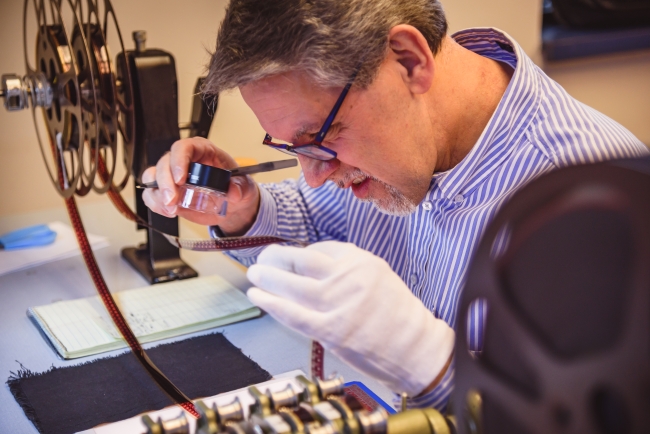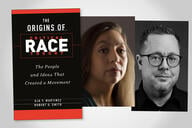You have /5 articles left.
Sign up for a free account or log in.

Emily Sterneman, IT Communications Office, Indiana University
In the basements and back rooms of universities across the country, boxes and boxes of video and audio tapes, discs and film reels sit rotting, their content slowly being permanently lost instead of saved for posterity. For institutions tasked not only with creating knowledge, but also preserving it, this is a big problem.
Digitizing and preserving this so-called time-based media requires specialized equipment, skilled engineers and a lot of cash -- resources that many institutions simply don’t have to spare.
Deteriorating and obsolete media is not a new issue, but it is one that has become increasingly pressing in the last few years, said Dennis Cromwell, director of the Media Digitization and Preservation Initiative at Indiana University.
Faculty at IU started expressing concern about the state of the institution’s vast audio, video and film collection more than a decade ago, said Cromwell.
In 2009, IU conducted a survey of its collection, with troubling results. More than 560,000 audiovisual objects were being stored at the institution's Bloomington campus, but only around 8 percent of these had been digitized. Nearly all items were described as “actively deteriorating, some quickly and catastrophically.”
Digitization and preservation efforts were already underway at IU, but none were going fast enough. The music library, for example, would have taken 120 years to preserve its collection had it continued at the same pace. IU estimated it only had a 15- to 20-year window to save its recordings, which include rare musical performances, oral histories, endangered and extinct languages, lectures, interviews, and original research.
In 2013, IU president Michael McRobbie committed $15 million to the MDPI to preserve some 325,000 audio and video recordings. Another $12 million was later added so that 25,000 film reels could also be preserved, said Cromwell.
The $27 million project, conducted in partnership with media digitization company Memnon, started in 2015 and is now more than halfway through its work. Cromwell said that MDPI is on track for completion by IU’s centenary in 2020. More than 92 percent of the audio and video collection has been digitized, as well as 19 percent of the film reels.
The MDPI project isn’t only about preservation, explained Cromwell, it is also about access. Where possible, the university plans to share its content in the public domain, through an IU-developed open-source platform called Avalon.
In choosing which works to preserve, and which not, Cromwell says his team “cast a wide net,” though they prioritized items that are unique or significant to the university over commercially available recordings.
"There’s a lot of really interesting stuff in there," said Cromwell.
This “interesting stuff” includes a treasure trove of traditional music, including wax cylinder recordings of Chinese folk music from 1902 -- thought to be perhaps the first audio recording in China, said Cromwell. There’s also an archive of Orson Welles’s radio programs, Native American oral histories, videos of surgical procedures, obscure foreign films and much more.
Not all materials identified for preservation could be saved, said Cromwell. Sticky shed syndrome -- a process by which magnetic tape deteriorates because of humidity, claimed several items, though sometimes “baking” tapes at low temperatures to reduce moisture can save them, he said.
Cromwell said that to his knowledge, IU is the only university undertaking such a large-scale preservation project.
“It does require a large marshaling of resources, of people and money,” he said. “I think we’re going to see more institutions doing this. It’s clear that any materials that are important to save really need to be transferred now.”
Working with a contractor is essential to completing the work quickly, said Cromwell. Memnon had the equipment and engineers to process materials at scale, but some more delicate work was done in-house, he said. IU’s contract with Memnon accounted for a large portion of the project’s budget, but the second biggest expense was archival and data storage, followed by temporary personnel costs.
Going forward, Cromwell says that IU will have a streamlined process for digitizing and archiving new materials added to its collection. Choosing the right file formats and technologies to preserve materials, as well as getting good metadata, has been a difficult process. But Cromwell hopes the newly saved media will provide exciting new resources to researchers.
Mary Molinaro, executive director of the Digital Preservation Network, a membership organization that helps institutions develop solutions for the long-term preservation of their collections, said that IU has been “unique” in taking such a comprehensive approach to the digitization and preservation of its collection.
“It’s an issue that people are really struggling with,” said Molinaro. “There are some pretty significant efforts going on, but nothing as comprehensive as at Indiana University.”
Cost is the biggest barrier to most universities doing such large-scale projects, said Molinaro. Of course every institution would like to save as many materials as possible, but in most cases it’s just not feasible.
“It’s like trying to drink from a fire hose,” said Molinaro. “You have to prioritize.”
Molinaro pointed to the University of Southern California’s work with the Shoah Foundation and Warner Brothers as an example of another large-scale preservation effort. Other institutions prioritizing media preservation include Stanford University, the New York Public Library, the Library of Congress, the Smithsonian Institute and many more.
Ann Thornton, vice provost and university librarian at Columbia University, said her institution is about to embark on a smaller-scale media digitization and preservation project starting this July. Following an initial survey, the university identified 59,000 unique materials that will be prioritized in the project. Thornton estimates the project will take at least six years, but the full cost is not yet known.
“Part of our work in the coming year is to figure that out,” said Thornton. A big part of that calculation will be accurately predicting how much digital storage space the collection will require. In the first year, Columbia will focus on preserving its collection of oral histories recorded on reel-to-reel tape, said Thornton.
Like at IU, the drive to preserve these media came from faculty, said Thornton. Similarly, Columbia wants to not only digitize and preserve its collection but also to make it accessible where copyright allows. Thornton said she’d like to see the materials become “much more integral to teaching and learning,” noting this possibility is something “faculty are really excited about.” Developing the university’s preservation procedures is important for future acquisitions, she said.
Though the university has been digitizing selected items over the years, preservation is now “a real strategic priority,” said Thornton.
Many universities have recognized that their materials, “especially magnetic media,” are deteriorating and now at “significant risk,” said Ian Bogus, executive director of the Research Collections and Preservation Consortium. ReCAP was formed by Columbia, Princeton University and the New York Public Library and is the largest off-site library shelving facility in the country. Harvard University is also an associate member.
“There are libraries that aspire to go through all of their AV media systematically, but it is a daunting task,” said Bogus. Which items are most at risk can depend a lot on the temperature and condition in which items are stored.
“It’s not just older materials that are at risk; newer things like CDs, particularly rewritable ones, are a huge problem,” he said.
Media preservation efforts are “gaining some steam” at universities, said Bogus, “but media is not our only preservation challenge -- brittle books are also a big issue.” Libraries are doing so many different things, it’s impossible for them to put all their resources into preserving content, said Bogus.
Bogus said that while not everything can be saved, “the trick will be trying to minimize the loss of important materials as much as we can.”




